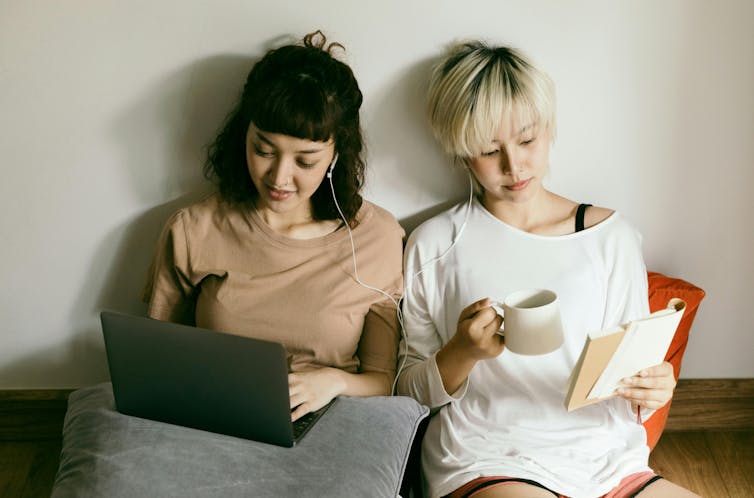Our research shows what the rental market is really like for international students
- Written by Hannah Soong, Senior Lecturer and Socio-cultural researcher, UniSA Education Futures, University of South Australia

International students have come under fire from both sides of federal politics in the past week.
The Albanese government introduced legislation[1] to parliament last Thursday to put caps[2] on the number of international students each institution can enrol. In his budget speech[3] Treasurer Jim Chalmers said “[international student] enrolments have grown without being matched by an increase in student housing supply”.
This puts pressure on prices and rents, especially in our cities and suburbs. It makes finding housing harder for every one.
In his budget reply speech[4], Opposition Leader Peter Dutton said the Coalition wants to cut the number of international students:
we will reduce excessive numbers of foreign students studying at metropolitan universities to relieve stress on rental markets in our major cities.
But is this fair? Our research shows[5] international students are finding it stressful and difficult to secure accommodation. And the largest proportion is already in purpose-built housing.
Students unfairly blamed
The housing debate often misses what international students bring to Australia. International education is one of Australia’s top exports and was worth A$47.8 billion in 2023[6].
Last month, a Property Council of Australia report[7] also found “international students are not the cause of the housing crisis”.
The report showed international students only make up 4% of the rental market in Australia. It points out rents started rising in 2020 during COVID “when there was no international student migration and most students had returned home”.
Our research
We have been researching the experiences of international students in South Australia. As part of a broader 2023 study[10], we surveyed 1,372 international students about their wellbeing, community engagement and housing situation. We also did follow up interviews with 16 students.
Students in the survey came from 142 countries and regions. Asia was the top source region with 38% of respondents, followed by Europe and Africa.
Respondents were studying at 27 institutions in South Australia. More than half of our sample were university students, but respondents were also studying at TAFE and private colleges.
Here we report our findings about housing.
Where are students living?
The biggest proportion of students in our study (25.5%) lived in the Adelaide CBD, of which 56% lived in student accommodation.
Students were then dispersed across the suburbs. The next biggest proportion of students in any given suburb was 2.2%.
Student accommodation was the most common type of housing for all students we surveyed (20.7%), followed by living in a shared house with a private bedroom (19.6%) and sharing a bedroom (13.2%).
Less than 1% of respondents lived alone and 2.5% lived in a property they or a family member owned.
This shows international students tend to live in the CBD and in student accommodation or shared houses or bedrooms. Many locals would not consider these types of housing suitable. So it is very difficult to see how they are driving up entire metropolitan housing markets.
How hard it is to find somewhere?
It is not as though international students are finding it easy to secure a place to live, either.
Students in our study reported finding suitable accommodation was one of the top three challenges undermining their life experience in South Australia (along with overall financial security and making local friends).
They told us how they often had little choice over where to live because they did not have a rental history or proper source of income. For example, a social work student from China was looking for a new place to rent but felt hopeless. She said she had sent out up to 40 applications but had no response.
We don’t have a renting record in South Australia and I don’t have a full-time job […] Lots of the [real estate] agents wouldn’t really want us […].
For many students, student accommodation was the only thing available, which they described as “very expensive” and “very compact”. One Sri Lankan student studying for a PhD in computing explained:
They are not going to give me a place […] the student accommodation was my only option. That’s why I chose it even though it’s quite costly.
Another Taiwanese student studying computing and information systems told us they had just A$150 to spend per month on food because the cost of student accommodation was so high.
What next?
Our research shows international students in South Australia are finding it expensive, difficult and stressful to secure a place to live while they are studying.
This suggests they are experiencing the problems of Australia’s housing crisis. But it does not indicate they are causing it.
We also need to be careful simply thinking more student accommodation will fix this issue. It does not address the problem of housing affordability and it does not help international students interact with their local communities in Australia.
It is also worrying to see international students blamed for a very complex problem, which experts acknowledge[13] has multiple causes, of which overall migration is only a “relatively small part”.
And we should not forget Australia has labour shortages in civil engineering[14] and construction[15].
So international students could be part of the solution to housing shortages, rather than mistakenly being blamed as the cause.
References
- ^ introduced legislation (ministers.education.gov.au)
- ^ put caps (theconversation.com)
- ^ budget speech (ministers.treasury.gov.au)
- ^ budget reply speech (www.liberal.org.au)
- ^ research shows (find.library.unisa.edu.au)
- ^ A$47.8 billion in 2023 (www.education.gov.au)
- ^ report (www.propertycouncil.com.au)
- ^ Ketut Subiyanto/Pexels (www.pexels.com)
- ^ CC BY (creativecommons.org)
- ^ a broader 2023 study (find.library.unisa.edu.au)
- ^ Cottonbro Studio/ Pexels (www.pexels.com)
- ^ CC BY (creativecommons.org)
- ^ experts acknowledge (www.abc.net.au)
- ^ civil engineering (www.jobsandskills.gov.au)
- ^ construction (www.jobsandskills.gov.au)

















